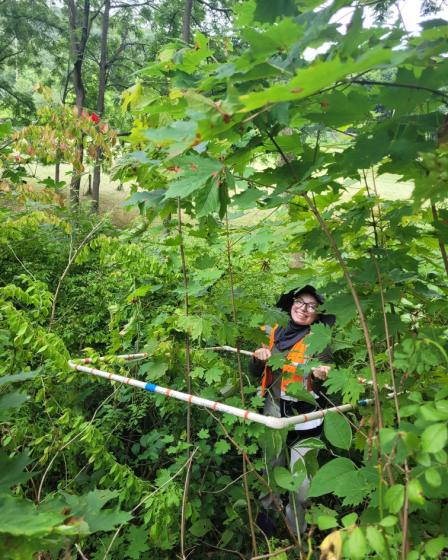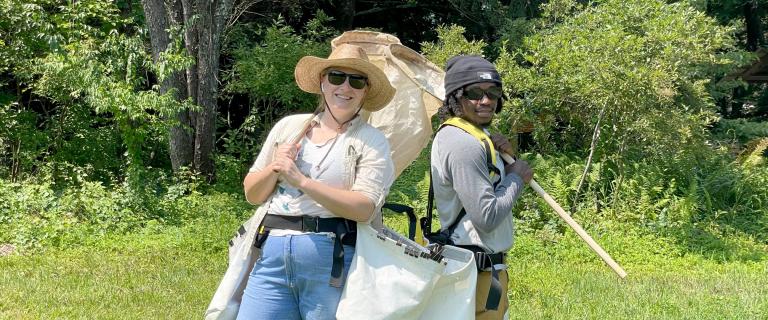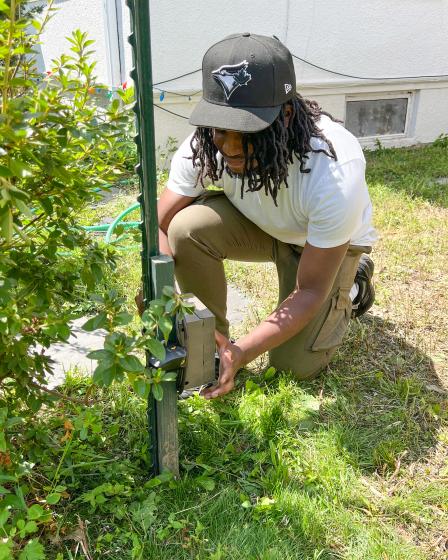

YSE postdoctoral associate Annise Dobson (left) and New Haven Promise intern Xavier Murrell collect grasshoppers at Flanders Nature Center in Woodbury, CT, on July 14, 2023, for research on how climate change is affecting the insects.

YSE postdoctoral associate Annise Dobson (left) and New Haven Promise intern Xavier Murrell collect grasshoppers at Flanders Nature Center in Woodbury, CT, on July 14, 2023, for research on how climate change is affecting the insects.
From measuring maple trees to studying soil samples to analyzing mineral deposits, four college students from New Haven spent the summer gaining a better understanding of the natural world, exploring new career paths, and contributing to Yale School of the Environment research.
The students, who attend colleges throughout Connecticut, are enrolled in New Haven Promise, a program founded in 2011 that provides tuition scholarships and paid internships to students primarily from lower-income communities in the city to help them access valuable work experience in their respective fields of study and pursue degrees at state universities and colleges. Since its founding, the program has provided funding to more than 2,200 students through Yale University, the Community Foundation for Greater New Haven, and Yale-New Haven Hospital.

Tracking changes in urban forests
Katelyn Miller says her YSE internship has given her a new perspective on small urban forests, particularly those in her hometown. A recent graduate of Southern Connecticut State University, she studied forest fragments in New Haven — particularly the often-neglected herbaceous understory plants that grow along the forest floor. She visited several parks in the city for her research, looking for signs of disturbances ranging from fallen trees to pathogens.
“I’d been to many of New Haven’s parks before, but I never thought of them as actual forests,” says Miller, who will be attending Sacramento State University this fall to pursue a master’s degree in ecology and evolution. “I figured that since I’m going to be in forests a lot, I should know about them.”
Marlyse Duguid, Thomas J. Siccama Senior Lecturer in Field Ecology, and Les Welker ’24 MESc helped direct Miller’s research, which builds on a longitudinal study done in collaboration with Connecticut State Urban Forester Danica Doroski MESc ’17 MESc, ’21 PhD that tracks how urban forests are changing over time.
“Urban forests in smaller cities have not been well-studied,” Duguid says. “Gaining a better understanding of how these forest patches function is vital to their long-term management, funding, and care.”
Duguid says Miller’s contributions were vital to the success of the project. “When you’re in the field, it’s very helpful to have one person identify what you’re looking at, another taking measurements, and a third taking notes. When we interviewed Kate, she was so engaged, and she’s been amazingly helpful.”
During her internship, Miller learned how to use PivotTable, an Excel tool for analyzing large amounts of data from different perspectives. She also became adept at navigating to the various GPS positions at the forest sites using Avenza, a mapping tool.
Her favorite part of the experience was measuring old maple trees.
“When you find a large maple in a forest, it may have been growing there for hundreds of years — maybe since the area was used as pasture for the livestock by early settlers,” she says.
Investigating natural climate solutions
Gershon Ariker, a junior at the University of Connecticut with a keen interest in animal science, spent his summer measuring cation levels in water samples that were collected from a farm in Vermont and then treated with crushed basalt. Cations are derived from minerals in soil including sodium, potassium, magnesium, and calcium. They also are found in water that leech from basalt.
The research is part of a study by Peter Raymond, professor of ecosystem ecology, on accelerating the natural weathering process that removes and sequesters carbon dioxide from the atmosphere. “Farmers spread minerals in agricultural fields to promote crop growth. In addition to helping the plants, the minerals naturally react with carbon dioxide to form carbonate ions and therefore sequester the CO2 gas,” Raymond explains.
Carbon dioxide capture is key to keeping global warming to 1.5 degrees Celsius over preindustrial times, which is the threshold that climate scientists warn is imperative for the future stability of the planet.
Ariker helped Raymond’s research team examine how carbon dioxide consumption rates change overtime, how often to apply basalt, and which types of rocks work better than others.
“Learning how to read cations was a little difficult at first, but I’m getting the hang of it,” Ariker says.
Alfia Ansari, also a University of Connecticut student, worked on a different aspect of the enhanced rock weathering project. The water samples she measured were taken from sites in Virginia. Like Ariker, this was Ansari’s first time working in an environmental science lab. “I learned how to collect and process water and soil samples, how to prep and run radiocarbon samples, how to determine the DIC (dissolved inorganic carbon) and DOC (dissolved organic carbon) of samples,” she says.

Stemming the threat of invasive jumping worms
Xavier Murrell, an animal science major at the University of Connecticut, worked on three different projects at YSE, including one examining multiple species of jumping worms from the Megascolecidae family.
While gardeners generally welcome earthworms as harbingers of soil health, the invasive variety that Murrell studied under the direction of Annise Dobson, a YSE postdoctoral associate, have recently found their way from Asia to gardens, parks, and lawns throughout New England, where they are making soil inhospitable for native plants.
“Jumping worms move in all different directions and break up the soil, so it has a texture like ground beef instead of regular dirt, and that can affect the way plants and trees grow,” Murrell says.
Dobson has been researching how the invasion of these ecosystem engineers is influencing regeneration of forests, carbon storage, soil and water quality, and food webs. Murrell provided data for Dobson’s lab research and co-authored an article with Dobson published in PA iMapInvasives on the threat of jumping worms to gardens, ecosystems, and landscapes.
“Getting familiar with the background literature helped Xavier understand why he was preparing soil samples all day, which can be really monotonous unless you fully grasp the purpose of the work,” Dobson says.
While Murrell was initially interested in studying wildlife habitat, he says his experience working with Dobson and others at YSE has led him to rethink his career path, and he now plans to study soil ecology.
“My focus was mainly animals. But working with insects and doing soil sampling has changed my perspective. Everything starts with the soil,” he says.